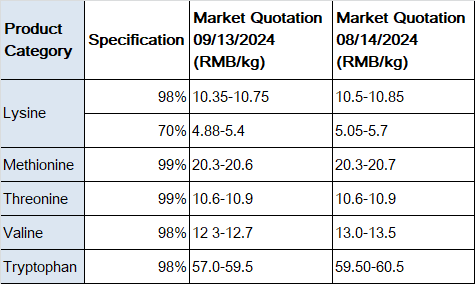Summary:
The
upstream supply of the amino acid market in China is normal, with an average
market purchasing and selling atmosphere, and downstream demand remains
rational and demand-driven. Lysine manufacturers' quotes are stable, with
average downstream inquiry and orders, and exports are strong; 98% lysine
hydrochloride manufacturers' quotes are steady, focusing mainly on export
orders; 70% lysine manufacturers' quotes are slightly weak, with some terminals
expecting a downward trend in the market, and demand is mainly for hard
necessities. Threonine is in short supply domestically, with high spot
transaction prices, and downstream users mostly maintain a demand-driven
procurement strategy. There is a strong expectation of a decline in the price
of methionine, which continues to be weak, with downstream demand remaining
sluggish and actual transactions scarce. Tryptophan market manufacturers'
quotes are slightly lower, with low downstream demand and slow restocking.
Valine manufacturers' quotes are weakly adjusted, with a light market
transaction volume.
Price Trend
Data source: ChemNet

Lysine, Valine, Tryptophan: Currently, the
factory quotes for 98% lysine are temporarily stable, with the issuance of
export orders being dominant. There is a higher downstream inventory for 70%
lysine, and the market expects prices to fall, which results in low enthusiasm
for domestic purchasing and selling activities.
Threonine, Methionine: Recently, the
factory quotes have been maintained at a relatively high level. In the trade
market, most merchants do not choose to build inventory. Manufacturers have a
strong control over the supply of goods, which keeps the market supply
relatively stable. The production cost of threonine is relatively stable, and
the main raw materials for methionine production are energy chemical products
such as propylene, methanol, and natural gas, whose price fluctuations are
relatively small. It is expected that the prices of threonine and methionine
will continue to remain stable in the short term.
Market Status and Influencing Factors
The current market situation and
influencing factors for amino acids, particularly lysine, valine, and
tryptophan, are as follows:
1. Demand from the feed
industry is growing slowly.
Currently, the demand for 70% lysine is
relatively weak. Data from the China Feed Industry Association shows that in
the first half of 2024, the total national industrial feed production decreased
by 4.1% year-on-year. Slow growth in feed production implies limited growth in
demand for lysine. Downstream users are cautious about the market, purchasing
rationally, and mostly buying on demand without hoarding. The lack of robust
growth in downstream demand makes it difficult for lysine prices to rise.
2. Weakening cost support.
Lysine production primarily uses corn as a
raw material, and corn prices have been declining since the second half of
2024. As corn prices fall, cost support weakens. In August, the average
national corn price was 2286.78 RMB/ton, a decrease of 3.50% compared to July.
Source: China Feed Industry
Information Network.
Future Outlook and Challenges
1、Expansion of Export Scale: Entering
September, the production of lysine manufacturers is expected to remain normal,
and the market supply is anticipated to be very abundant. At the same time,
orders for the fourth quarter have already been signed overseas, and the
manufacturers' willingness to support prices begins to emerge, which will play
a strong supporting role for the domestic market in China. The promotion of corporate
internationalization strategies is also continuously expanding into overseas
markets. Companies will improve the international reputation and market share
of their products by participating in international exhibitions, carrying out
international certifications, and establishing overseas sales networks.
2、Growth in International Market Demand: The
global demand for amino acids continues to grow, especially in developing
countries, where economic development and the improvement of people's living standards
have led to an increasing demand for protein and nutritional health products,
thereby driving the growth in demand for amino acids. As a major global
producer of amino acids, China has cost and quality advantages and can meet the
needs of the international market.
In general, In September lysine
manufacturers' production is normal and the supply is sufficient. Overseas
fourth-quarter orders lead manufacturers to support prices, which helps the
domestic market. Globally, the demand for amino acids is growing, especially in
developing countries. As a major producer, China has cost and quality
advantages. With the improvement of living standards and the development of
pharmaceutical and food industries, the demand for high-value-added amino acid
products is rising. Technological innovation, like new fermentation processes
and optimizing strain selection to reduce costs and increase production, drives
the industry. Developing high-value-added products and continuous innovation is
an important trend for meeting market demand and enhancing competitiveness.
About CCM:
CCM is the leading market intelligence provider for China’s agriculture, chemicals, food & feed and life science markets. Founded in 2001, CCM offers a range of content solutions, from price and trade analysis to industry newsletters and customized market research reports. CCM is a brand of Kcomber Inc.
For more information about CCM, please visit www.cnchemicals.com or get in touch with us directly by emailing econtact@cnchemicals.com or calling +86-20-37616606.